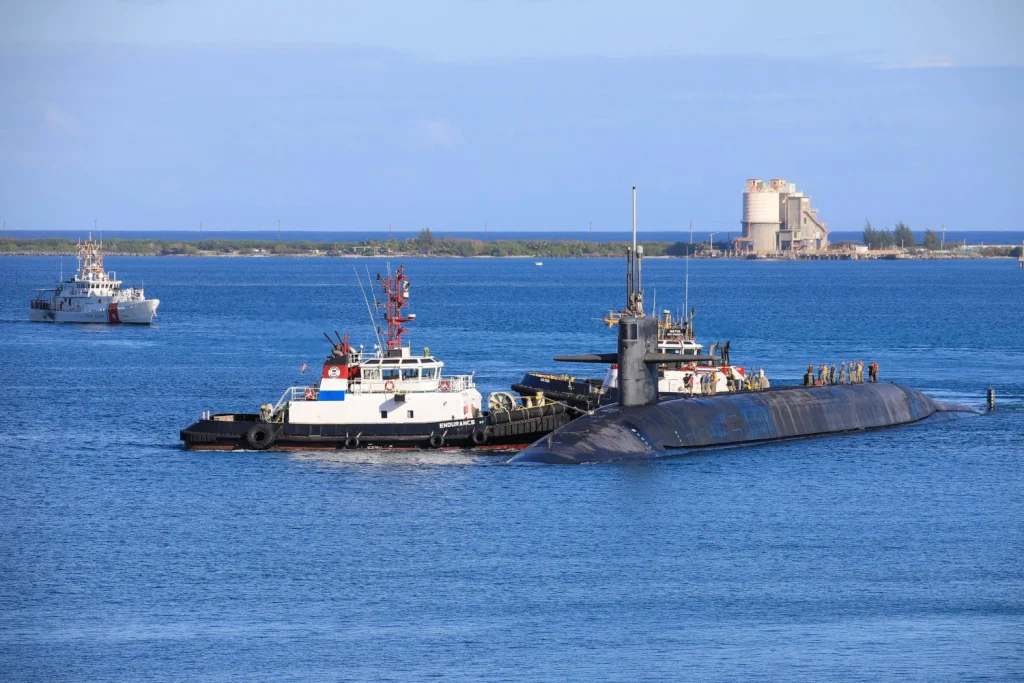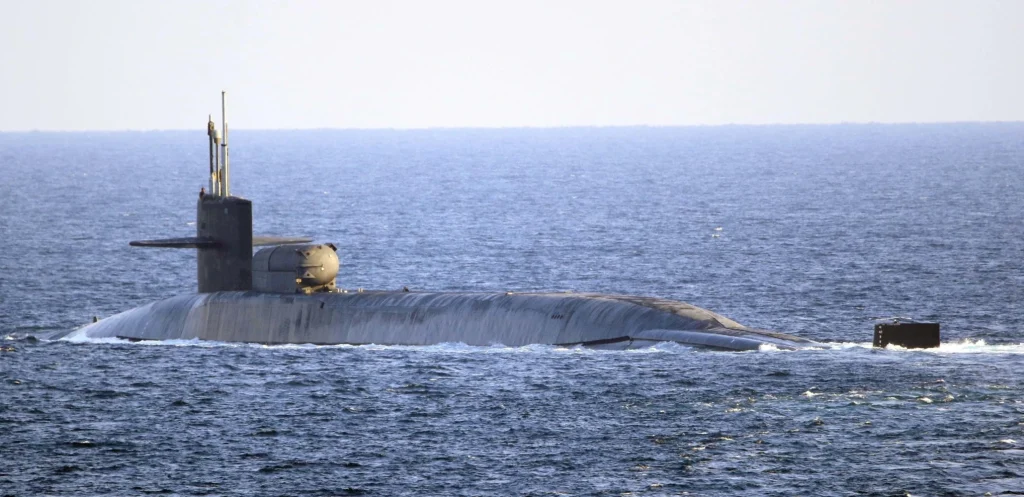A U.S. Navy nuclear submarine deliberate surface passage or surfacing is considered signalling a message to the foes on Washington’s obligation to protect its allies.
This week, the U.S. Navy’s 6th Fleet revealed the location of the USS Georgia (SSGN 729) submarine near the island of Cyprus.
USS Georgia is one of four Ohio – Class nuclear submarines. It can connect to special operations control and mission planning centres and has sensors for successful operation in shallow water. Of the 24 launchers, 22 can launch Tomahawk BGM-109 cruise missiles with a thousand miles range. The balance of the launchers is used for exit and entrance onboard the vessel for the advanced SEAL delivery system (ASDS).
The exact reason for the submarine’s surfacing is unknown as the U.S Navy has not explained it. It may be related to the carrier strike group led by USS Harry S. Truman, which is in the Mediterranean, or the United States could be sending a signal to NATO allies and Russia that they are ready to strike if necessary.
U.S. Navy submarines very rarely disclose their location. They tend to stay underwater so that adversaries cannot determine where the sub would go next.
At the moment, the reason for the appearance of a submarine in the Mediterranean may be Ukraine. The situation around this country, as the West believes, is approaching a catastrophe. In this regard, the U.S. Navy decided to remind, probably primarily Russia, that being off the coast of Cyprus, the submarine can attack targets in the Crimea and other coastal regions of Russia and Ukraine.
However, the Russians are unfazed. Crimea is one of the heavily defended areas of the world. USS Georgia can fire single shots and volleys, and the Tomahawk missiles leave no stone unturned to reach their target. But Tomahawks are subsonic, meaning they move at a speed less than the speed of sound. Unlike previous strikes by Tomahawks, this time they face the continental air defense system in Crimea. It includes both the S-300 and S-400 anti-aircraft missile systems. The ships of the Black Sea Fleet also have S-300s. There are also long-range missiles of the S-75 type that successfully work on low-flying targets. Even if Tomahawk penetrates through these systems, it has to contend with the Pantsir-S anti-aircraft missile and gun systems.
Also read – Russian Aerospace Forces will receive new equipment in 2022, including hypersonic weapons
Russia is building a tiered defense on the peninsula, dictated by the need to cover strategically important facilities and respond to the increase in NATO’s military presence in the Black Sea region.
Russia is also deploying the latest medium-range air defense systems S-350 Vityaz with arsenal four times larger than the ammunition load of the S-400. This system can destroy targets in the sky at ranges over 120 kilometres and at altitudes over 30 kilometres. It takes just 5 minutes to deploy the system.
The Russian Defense Ministry said that six amphibious assault ships left the Baltic Sea this week are on their way to the Mediterranean, participating in exercises. They are expected to monitor the USS Harry S. Truman led Fleet.
USS Nevada in Guam
This month, the U.S. nuclear submarine USS Nevada, capable of carrying multiple ballistic missiles and nuclear warheads, entered its base on the island of Guam for the first time in six years.
Nevada is one of the most powerful military weapons in the U.S arsenal and took part in a rare manoeuvre at the U.S. base in Guam as tensions between China and Taiwan escalated, and North Korea conducted several rocket tests.
USS Nevada, an Ohio-class nuclear submarine, carries 20 Trident ballistic missiles (equipped with multiple independently guided warheads) and dozens of nuclear warheads.
For the first time in more than six years, a U.S. Navy nuclear submarine has been sighted off the coast of Guam and the second time since the 1980s.

In a statement, the U.S. Navy assured that the visit aimed to “strengthen the cooperation” with regional allies and demonstrate the country’s commitment to security in the area.”
The media immediately pointed out that Taiwan was just 3000 km away from Guam.
The fact that the Navy went public with a nuclear submarine visit is entirely unusual since such sorties are usually covert operations and their whereabouts are generally unknown when they are underway.
Unlike Russia, China is weak in air defenses and offensive capability against the U.S Navy. China does possess a larger fleet compared to the U.S. Navy but fairs poorly in terms of technology.
Explicit messaging
In the immediate past, the U.S. Navy has explicitly stated that the presence of the warship or submarine is a message to its enemies.
In January 2021, an ASH-3D Sea King helicopter of the Iranian Navy Sea King spotted the USS Georgia nuclear submarine en route at periscope depth to the Iranian Navy’s training area and offered to leave the site.
The Ohio-class nuclear-powered guided-missile submarine USS Georgia (SSGN 729), along with the guided-missile cruisers USS Port Royal (C.G. 73) and USS Philippine Sea (C.G. 58), transited the Strait of Hormuz, entering the Persian Gulf towards the end of December 2020. The 5th Fleet operations cover about 2.5 million square miles of water area and include the Persian Gulf, the Gulf of Oman, the Red Sea, and parts of the Indian Ocean. The region comprises 20 countries and three chokepoints critical to the free movement of global trade.

The Pentagon announced that a U.S. nuclear submarine would cross the Strait of Hormuz for the first time, escorted by other warships.
A Pentagon spokesman said the submarine’s passage is a message to Tehran and Washington’s obligation to protect its allies, noting that the USS Georgia submarine is armed with more than 150 Tomahawk missiles.
The submarine’s crossing comes just hours after U.S. Middle East Commander General Frank McKenzie said his country was “ready to respond” if Iran attacked it on the first anniversary of the assassination of General Qassem Soleimani.
“We are ready to defend ourselves, our friends and allies in the region, and we are ready to respond, if necessary,” he told reporters.
The crossing happened a day after the Green Zone in Baghdad was hit by five Katyusha rockets, landing near the U.S. embassy in Iraq.
Graded threats
The U.S. appears to threaten small countries in explicit terms in the case of a submarine deployment like Iran’s case. In the case of China, which is stronger than Iran, the U.S has issued a general statement of threat. As for Russia, the U.S had kept completely mum as the stake is the greatest.
Such grading is not visible when the U.S. conducts the freedom of navigation patrols.
